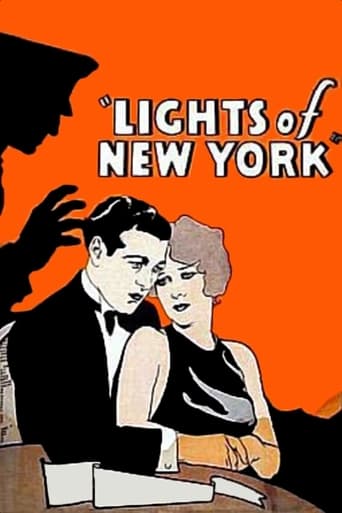

Lights of New York (1928) ** 1/2 (out of 4)Eddie (Cullen Landis) lives in a small town but dreams of the big city just forty-five minutes away. He talks his mom into letting him go to New York City to visit his girl Kitty (Helene Costello) as well as try to make something for himself. Before you know it Eddie is in New York but he's gotten conned into a bootleg racket by the criminal Hawk Miller (Wheeler Oakman).Everyone knows the history of THE JAZZ SINGER and how it introduced the world to talking pictures. That movie only had portions of it that were sound but all of that changed with LIGHTS OF NEW YORK, which would be the first all sound picture. It's rather interesting that the film has so much history behind it and yet it was hard to see for many decades and just finally got released to DVD in April of 2018. When you watch this film you can talk about its place in history, the technique of its use of sound and the movie itself. I'll start with the movie itself, which is mildly entertaining thanks in large part to it just running 57-minutes. The film is rather short but there's no question it's rather unoriginal and especially the story of a small town boy going to the "evil" big city and finding bad stuff. It's not original and there's nothing fresh done with it outside of the dialogue and sound effects.The performances are all pretty stiff but this here goes to the technology. Mics had to be hidden all over the place to pick up the actor's dialogue and quite often the actors had to stand very close to them. You can tell there were various problems because more times than not the actors in the film are standing close to each other for no reason than so the mics can pick up what they're saying. In fact, there's one scene where you can hardly hear a woman speaking until she takes a step up and then her dialogue becomes audible. With that in mind, it makes sense why some of the performances are rather bad and at times the actors seem to be shouting to get them heard. It should be stated that the star of the picture, Landis, appeared in over a hundred movies but would just make two more after this one.LIGHTS OF NEW YORK is certainly going to appeal to film buffs who want to see the first sound picture. That alone makes it worth watching but it's also fascinating to see where the technology was at this point and how it hampered the picture. There are some obvious issues with the picture and there's no question that it doesn't have anything original about it but at the same time the movie remains entertaining and worth watching.
... View MoreI love to catch early talkies on Turner Classics (the only place I can ever see them), and the earlier the better. Usually 1929 is the best I can do. I saw one called Tanned Legs that featured stilted dialogue spoken by people clustered around potted palms. Well, this one isn't much better, folks, but as an unintentional comedy it works quite well. The thing is, no one moves in this thing, except for a few chorus girls who are trotted out from time to time. The felt-hatted gangstas sit so close to each other that their foreheads are almost touching. In fact, everyone gets up-close and personal in this thing, maybe because they're afraid to move or the mic won't pick them up. It's been described as "stagey", but it's more like "nailed in place", so static that the characters begin to resemble cutouts glued onto popsicle sticks and moved around only when it's time to change microphones. I'd see it, however, if you're curious about how sound film developed. This was a quick cash grab and it worked, though the critics soon buried it. Within a couple of years we'd have Garbo asking for "whiskey, baby. . . and don't be stingy." Guess they had to start somewhere.
... View MoreThis is an important historical film since it was the the first all-talking feature film. The film was made for a mere 23,000 dollars.It grossed over a million dollars upon its release. This film all so helped define the gangster melodramas that were to become the bread and butter of the Warner's studio in the 1930's. The popularity of this film ended the silent era more so than its more famous part-talkie predecessor, the Jazz Singer. The film deserves its place in history and not as a mere footnote. The only actor who might be remember today that is in it was Eugene Palette.
... View MoreIt is easy to criticize this movie,which has so many shortcomings.But in all fairness we must remember what handicaps everyone was working under.Actors had to speak slowly,and enunciate very precisely to make sure that the primitive microphones could pick up what they were saying.The fact that they were shooting an entire feature as a talkie, instead of just a few isolated scenes,as in previous "talkies",undoubtedly put extra pressure on everyone. To my mind one of the funniest(unintended) aspects of is, when Hawk was telling his two henchmen to "take him for a ride", one of the henchmen looked, and was dressed, like Stan Laurel! Sort of hard to take him seriously as a hit-man! Primitive as it was,this was still a wonder to audiences who had grown weary of the limitations of silent movies.I have always like old silents, but a steady,exclusive diet would get tiresome very quickly.The jeering reaction of the audience in "Singin in the Rain" to the shortcomings of "The Dueling Cavalier" was an anachronism;that is the reaction of an audience used to PERFECTED sound movies.An actual audience of the day might have laughed,but still would have loved it.
... View More